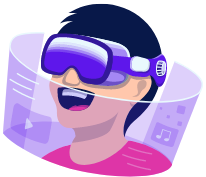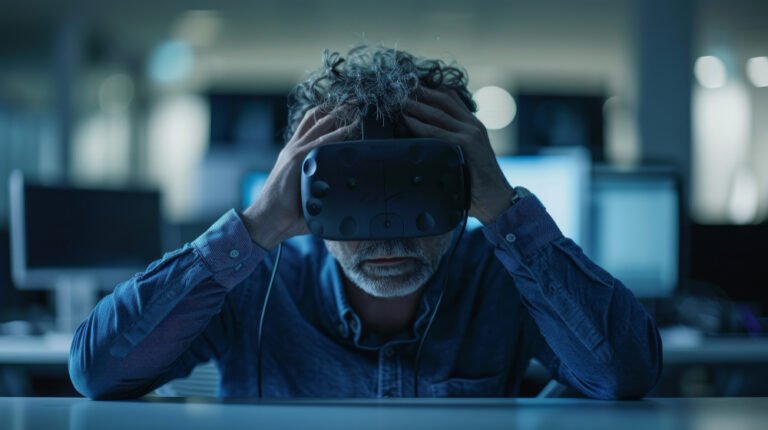Virtual reality (VR) has brought a whole new dimension to digital content, introducing realistic experiences where such was deemed unachievable before. As awesome as it is, VR has a fair amount of hurdles to tackle; none more so than in the form of “VR motion sickness”.. In this article, we will go through what VR motion sickness is and the cause of it as well how does It effect the user also precautions taken by companies like Meta or Apple to reduce its effects. We will then go over the pros and cons of VR as well provide some useful tactics for users to solve this problem.
Table of Contents
What is VR Motion Sickness?
VR motion sickness happens when our eyes see something in the VR environment that doesnt agree with how your body is moving. Such a disconnect can cause sensations that are similar to what is seen in classical motion sickness – dizziness, nausea, headaches and confusion.
In a VR headset, you see motion with your eyes but not feel it anywhere in the body. If a user is sitting still and looking down, they anticipate their head to move in response as they look around the virtual world. The mismatch between what they are feeling and something that does not fit is very confusing for the brain, making it uncomfortable.
How VR Motion Sickness Affects Users
Different people may feel symptoms differently; some might have to put the headset off after a few minutes, while others could still play for hours without any symptom. Causes of VR motion sickness :
- Frame Rate: If the frame rates are low, it can lead to a choppy experience and increase discomfort.
- Field of View (FOV): Its limited range makes you feel less enveloped and can contribute a lot to motion sickness in users A wider FOV can increase immersion, but it may also cause nausea if balancing between realism and perception is inaccurate.
- Latency: if the latency between us moving our head and seeing the visual feedback is great then we feel a separation in vision which makes a lot of people sick.
- User Sensitivity: Some people are more sensitive to motion sickness than others. There are also a few users who might experience more motion sickness – usually due to their past experiences or health.
PRECAUTIONS TAKEN BY VR COMPANIES
Recognizing the prevalence of VR motion sickness, companies like Meta and Apple are actively working on solutions to reduce its occurrence.
1. Meta Quest

So, while in a world where VR motion sickness is quite common and very real, companies such as Meta or Apple have their work cut out for them to minimize it.
- Advanced Tracking Technology: Understands next-gen tracking know-how to take up least latency on Meta Quest headsets. This also reduces the chances of motion sickness since visual response (what the user sees) will be closely aligned to what motion controllers do.
- Smooth Frame Rates: The new Meta Quest devices are meant to suk help high frame rates in order for everything user sees and does on screen scrolls like liquid, making the application experience that much greater. Choppiness can be triggered by lower frame rates, but higher frame rates ensure the smoothest visual experience possible.
- Comfort Modes: Meta provides options for adjusting comfort levels to cater users accordingly. For example we could add ways to reduce FOV or motion in games and apps, making them more comfortable for sickey users.
- In-Game Reminders: Some Meta VR applications have reminders that can be set up, and this is a good quality of life feature since the user will know they should take a break after some time.
2. Apple Vision Pro

The Vision Pro headset is marking Apple’s place in the AR/VR arena, proof that when it comes to user comfort and safety. There have been a variety of ways Apple has tried to address privacy, including:
- Dynamic Refresh Rates: The Vision Pro uses dynamic refresh rates to keep up with the user’s head movements so that it won’t cause motion sickness due to mismatched frame rendering.
- Spatial Awareness: the headset designed to combine an AR-like experience with VR, letting you stay aware (to some extent) of where your are spatially. This capability lessens the feeling of seasickness caused by your vision not agreeing with what it is you’re reveling in.
- User-Centric Design: Apple focuses on user experience through the rigorous design of device, ergonomically tailored to reduce ergonomic stress during use; A comfortable headset promotes a better experience and can help reduce some of those distracting elements that might be making the motion sickness worse.
- Guided Experiences: Apple touts guided experiences in apps to allow new users the time they need to become familiar with virtual environments and help prevent motion sickness.
Solutions to Overcome VR Motion Sickness
- Gradual Acclimation: Begin with only small amounts of VR time daily and gradually increase it as you get more comfortable.
- Choose Comfort Settings: Use the comfort settings that developers offer in VR applications to lower chances of motion sickness like set FOV and disable some motin effects.
- Stay Hydrated: Staying hydrated and drinking water can help mitigate some of the nausea symptoms that may occur with motion sickness.
- Take Frequent Breaks: Take breaks regularly during VR to help reduce the intensity of symptoms and give your body a chance to adapt.
- Use Ginger or Other Remedies: For years, ginger has been praised for its ability to combat nausea. Ginger tea or ginger candies before a VR play session can also help prevent motion sickness.
- Positioning: if you are not stable, this will reduce the sensation of moving while using VR.
- Mindful Breathing: mindfulness Keep control of the breathing, this ca n assist handle anxiousness or perhaps misery throughout a VR session and forestall symptoms from motion sickness.
Conclusion how to stop VR motion sickness
Currently, VR motion sickness is still a major obstacle in the world of immersive technology but improvements are being made to make it more enjoyable and easier on users by companies like Meta and Apple. Understanding the causes of simulation sickness and following our preventative suggestions can help you to reap all those amazing virtual reality rewards without all those ugly side effects. With the rise of technology, we can look forward to more VR innovations that will make it so almost anyone could experience and enjoy it.
FAQs About VR Motion Sickness
1. What causes VR motion sickness?
VR motion sickness occurs when the visual input and your physical movement are out of sink or dont match, causing mumbo jumbo in our heads.
2. How can I prevent VR motion sickness?
To avoid VR motion sickness, step into the experience slowly, adjust to comfort modes or turn them off
3. Are certain VR applications more likely to cause motion sickness?
Indeed, a high frame rate or movement speed in an application is far more likely to cause motion sickness than effects seen as slower-paced and/or stationary.
4. Is VR motion sickness permanent?
Not really, VR motion sickness is mostly short-time period. With time, most users will be able to adapt with proper practice and incremental exposure to VR environments.
5. Can children experience VR motion sickness?
yes, kids can get VR motion sickness too. You will also need to keep an eye on how much they use the headphones, and make sure that your kids taken regular breaks while using them

